How to Make Prickly Pear Syrup
September 21, 2015 | Updated June 17, 2020
As an Amazon Associate I earn from qualifying purchases.
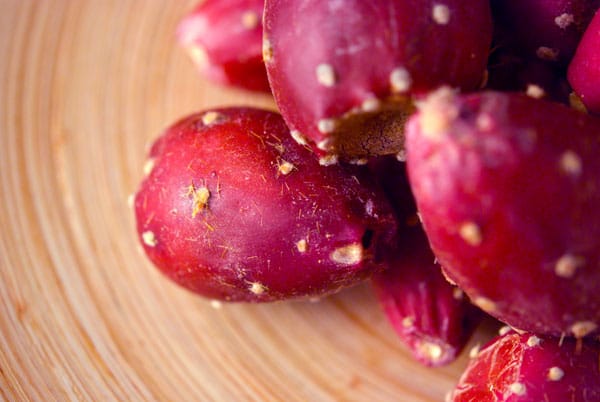
Well into my adulthood, all I knew about prickly pears was that they are the fruit of a cactus, the Sicilians eat them, and that according to Baloo, they are a bear necessity. I’d filed them in the back of my mind to the “someday I’ll get to it” list, along with perfecting bechamel and giving a crap about edible foams.
But when I moved to California years ago, I saw them everywhere.
Prickly pears are a common landscaping plant, one I’ve taken to growing in my own yard.
The fruits, often called tunas, come in all sizes and colors, ranging from teeny to larger than an orange. The larger ones are worth eating as a fruit, but the little ones are best for prickly pear syrup, which is what I first made with this fantastic cactus fruit.
The first time I brought some home, life intervened and they sat in my fridge in that paper bag for nearly a month. Apparently prickly pears store really well in the fridge. I’ve since kept them in a paper bag in the truck for a week and they were fine.
If you want to eat the fruit, you need to get these little flavor grenades out of their spiky skins. Second lesson learned: It’s not the big, seemingly vicious spines you need to worry about. It’s the hairlike “glochids,” which cover the fruit, that you need to worry about. Hated, evil glochids. Even the name sounds like some monster in a George Romero film.
Instead of skinning, you can also torch the pears briefly, which burns off the glochids. My friends Elise and Garrett have a method for skinning prickly pears that works well, too.
Regardless of how you use your tunas, you need to separate the seeds from the pulp. Garrett and several others say the seeds are edible, but they are either high or have far stronger teeth than I do; it’s like eating a wood chip.
Prickly Pear Syrup is dead easy. No skinning or burning required. Simply cover the fruits with water, bring to a boil, cover and let steep for 30 minutes or so. Mash with a potato masher, run through a food mill to remove the seeds, and then strain, strain strain.
I am something of a fanatic when it comes to clarity; I developed this particular neurosis from making wine. So I pass the pulpy juice through a fine-meshed sieve and then again through cheesecloth or a plain paper towel.
After that, I add an equal volume of sugar and bring it to a simmer to thicken a little. Once the sugar was good and dissolved, I turned off the heat and added some citric acid.
Why? Third lesson learned: Prickly pears, which taste like a combination of bubble gum, watermelon and strawberries, are mostly lacking in tartness. An exception is the variety the Mexicans call xoconostle. Without tartness, fruit is not very tasty.
Why citric acid? I wanted a neutral acid, not lemon juice. They’re close, but not the same. Lemons bring other flavors to the party, and I wanted this to be prickly pear’s show.
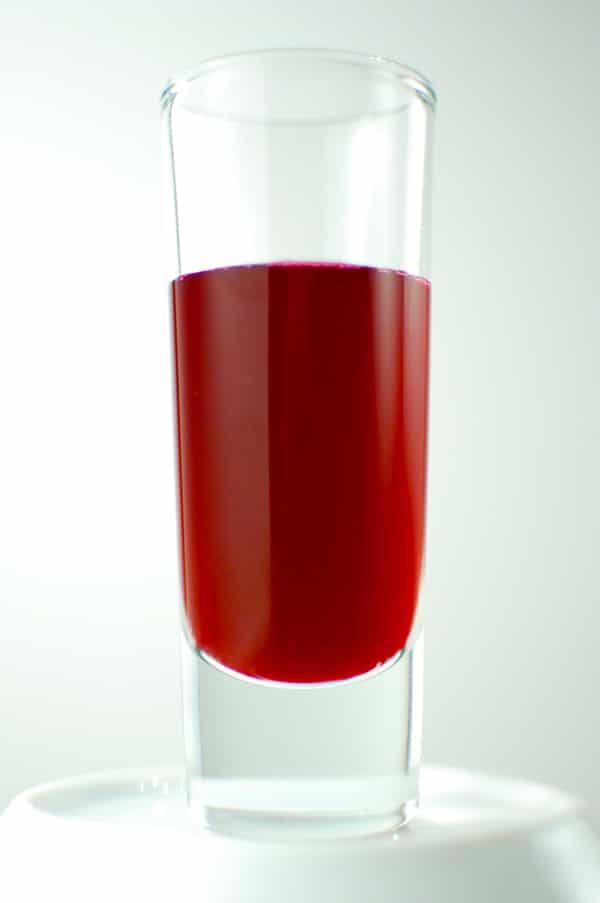
The result? Pure magenta power.
This prickly pear syrup rocks. The citric acid gives it just the right tang, and it brings out the watermelon-bubblegum elements and holds the color; it’s also a good preservative.
My initial use: Mixed with tequila, of course. Cactus and Agave. Duh! After that obligatory start, you can make sorbet, a vinaigrette for a salad, a souffle, or a glaze for game birds. If you want to do that, here is a glazed pheasant recipe that works just fine with a regular chicken (or quail or grouse), as well as with other glazes such as maple syrup, honey or another fruit syrup.
What’s the takeaway? Stretch a bit. Expand your horizons and work with new flavors. Some, like this one, will become new staples for your personal kitchen.
Prickly Pear Syrup
Ingredients
- 3 pounds prickly pears
- Water to cover
- 3 cups sugar
- 1 tablespoon citric acid, or the juice of 2 lemons
Instructions
- Put the fruits in a pot and add enough water to almost cover them. Cover and bring to a boil. Turn off the heat and let steep for 30 minutes.
- Mash the fruit with a potato masher, then push it through a food mill to separate out the seeds.
- Strain the pulpy juice through a fine-meshed strainer, then again through the same strainer that has either cheesecloth or a plain paper towel set inside. You need to do this to be sure of removing every last glochid.
- Measure the strained juice, and pour it into a pot. Add an equal amount (by volume) of sugar and bring to a simmer over medium heat. Let it simmer for 5 minutes. Turn off the heat and let it cool for 15 minutes. Add the lemon juice or citric acid. Add a little at a time and taste it. Stop adding when it is tart enough for you.
- Pour while still hot into clean Mason jars and seal. This should keep for months in the fridge, or you could process it in a boiling water bath for 10 minutes and keep it in the pantry; the citric acid helps preserve the syrup.
Notes
Nutrition
Nutrition information is automatically calculated, so should only be used as an approximation.

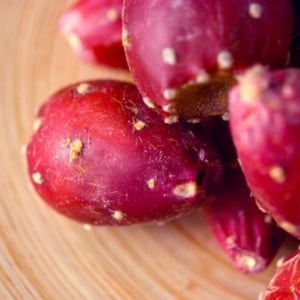
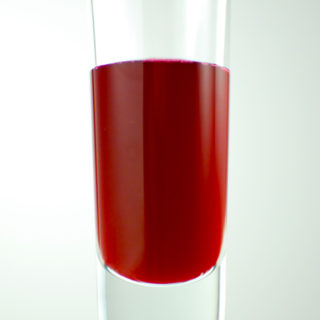
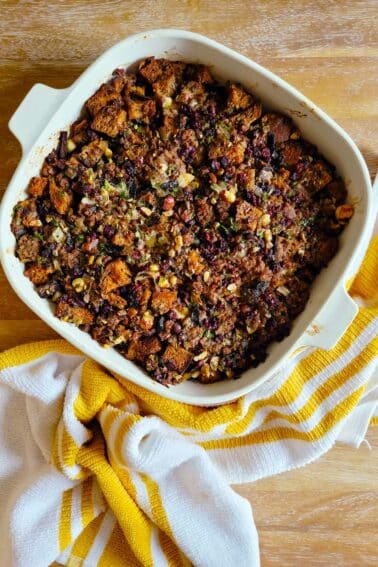
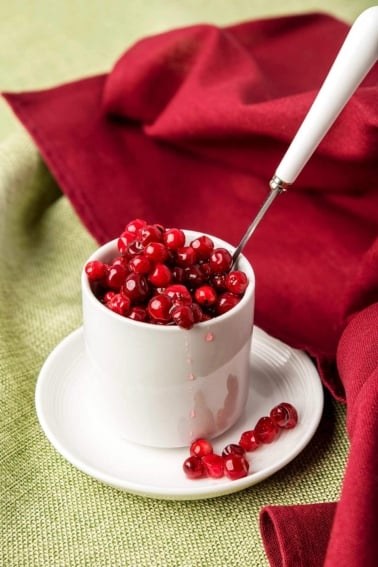
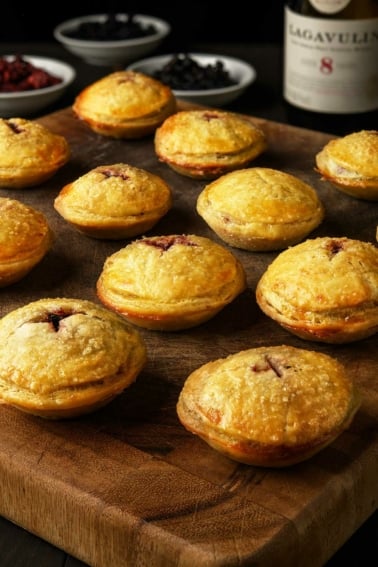

Syrup is amazing! My pears are the color of sunset and taste a little more tropical than the purple pears. Citric acid really made a difference. Added a cinnamon stick to haft the batch and can’t wait for breakfast tomorrow. Thanks for the recipe.
Excellent post!! I picked some PPF this weekend down in NC from my uncle’s yard. I knew I wanted to make a syrup out of them and you’ve delivered the perfect (easy) recipe.
I guess I’m an overachiever. I went out and picked a couple of 5 gallon buckets of the stuff. But I’m delighted to have this recipe. I told my friends, if they get a bottle of prickly pear syrup from me for Christmas, know that I bled for them and they’d better toast me with a prickly pear margarita for my sacrifice.
Thank you, you answered all the questions I had!!! Grateful!!! Evil little hairy pricklers.
This looks like a great recipe! Can I substitute agave syrup for sugar and still have it preserve safely in the hot water bath?
Chrissy: Probably? You’re dealing with a liquid sugar rather than a solid, so you will have to tinker with it.
Can you check to see if the syrup will b thick b4 bathing for longer storage?
This might be over kill but if you make wine like I do, it’s worth it. We call them pear burners in Texas, and not talking about Bartlett. Saved many a ranchers butt in hard times and this is the cheapest I’ve found. Ive used a combination of burning and freezing, or burning and boiling (more like steaming, really). If you freeze them, they turn to mush readily and you can add them directly to your primary fermenter. You don’t have to burn them at all, just makes them more convenient to pick. Boiling ( really boiling) like you would to peel a tomato gets rid of them and you can handle them after you take them out of the water. Or just chop and strain and nothing else and throw out the pulp…
https://m.harborfreight.com/propane-torch-61589.html
Thanks Hank
@ Malika–wow, that’s fascinating (the Eczema treatment)!
@ everyone else. I bought some prickly pears at HEB down here (San Antonio) but they are greenish. Can I still make the syrup? Thanks.
Peejay: I’ve seen those at the HEB when I am in Texas. I think the answer is no. They are unripe. I honestly don’t know if they will ripen off the cactus, though…
I am from Morocco and we have always eaten the cactus fruit. They grow everywhere! I cant wait to try making this syrup.
In case you were not aware in Morocco we also make the seeds into a fantastic oil which we use as a natural antiaging moisturiser. It is excellent for skin problems as well like Eczema. The oil is made in other countries but it just isn’t as good – but I may be biased 🙂
But we have to use 1000KG of fruit to make just 30KG of seeds which makes 1 litre of oil!.
Regards
Malika
I just made this. I usually have citric acid around the house but I couldn’t find any so I used lemon.
Now to find uses for it.
I’m making Pears poached in wine for dessert tomorrow. thinking about using this is a drizzle.
We had *the* best prickly pear margaritas at a restaurant a while back, so after our bike ride this past weekend where I saw so many beautiful magenta cactus buds I thought I’d try myself. I’m working on straining the stuff now, and it’s gelatinous and gooey and I’m having a tough time feeling like I’ve got all the ‘good stuff.’ I don’t have a food mill or a potato ricer- any tips? I’m starting out with an old metal colander with fairly large holes for my first strain, working it with the back of a ladle, but it still seems I’m leaving so much behind. Gelatinous and gooey- anyone?
Just to let readers know, you will still get the hairs in your body when you burn them. We attempted prickly pear jam this past season. Got hairs everywhere, even when I wasn’t touching them, just in the same area. We did discover a way that was more complete than the burning method. First we soaked them in warm water for a few minutes and then using a metal colander/strainer swirled them around under running warm water. The hairs came out more so than when you put them in fire.
Sadly our attempt at jam didn’t work but we did get an awesome sweet syrup for pancakes and I will be using it on our ham for Thanksgiving.
I have been processing prickly pear fruit for 5 years now – about 50 to 60 pounds… i have worked with the fruit several ways – including peeling, steaming, torching, and freezing is really great. Pick, wash and chop into a freezer bag and freeze. Remove from freezer and thaw. You get a bag of juice that can be strained and even put through a potato ricer to get it all … one full gallon freezer bag gives about 5 cups of juice. I then make the syrup, using tapioca starch (gluten free) and sugar or Xylitol, maple syrup … anykind of sugar 1/8 c. to a cup of juice .. so it is low sugar. adding at the end lemon juice and almond extract – very yummy flavor. I also add the syrup to cooked apples (the only liquid i use) and puree and then put on plastic sheets in my dehydrator and make fruit leather – a big hit with all!
I have made liquor by soaking a bowl of them in vodka for 2 weeks then strain then added sugar syrup, orange peel etc and makes a great little sip after meals.
I’m very familiar with prickly pears. My Dad has commercial grade growing on the edge of his property as a fire break between him and the canyon. They are huge, purple fruits.
I’m familiar with the hair like prickers too. He’s tried everything. A blowtorch. Boiling them. Or putting on leather gauntlets and using the longest tongs he could find to skin them. Still had stickers.
But oh, the fruit. And you can eat the seeds. You don’t chew them. You mush the fruit in your mouth and then you swallow it seeds and all.
I would love to make jelly and syrup. Didn’t know the trick with the citric acid.
If I can manage a way to pick and peel them without the stickers, I might give it a try.
Just a correction tequila is not made from a cactus but an agave.
I take the whole fruit and put it in the blender with a bit of water, then strain it, thru cheese cloth. I always wear heavy rubber gloves during this process. This year we processed 5 gal. of juice to make jelly, and some which did not jell is syrup.
Mary: Indeed you are correct! But they’re still really good together.
I Put on a a double set of surgical gloves when I begin to process my fruit. First I soak the fruit well in a large bowl of water, drain, (many glochids float away)and then cover the fruits with boiling water. Wait a few minutes, drain, Trim ends, cut them in half, scoop out the centers then scrape the skins. I put all except the skins into the food processor, liquify and then pour into my yogurt strainer and refrigerate. 24 hours later I have beautiful juice and then follow the recipe in this article. This makes a most tasty syrup without extra cooking. This week I am scattering the seeds which have not been cooked, around our land for future yummy syrup. Thanks for your article.
these are, without a doubt, the best fruits of the fall/winter season (they ripen here closer to november and last on the cactus through to december..)
i have to say though, i really prefer them raw, after skinning, and eat the seeds too-
they are so lovely; they are also good with all the fruit pulp mashed on top of ginger or vanilla ice cream..kind of like a ‘granita’ on the ice cream..
skinning is easy-peasy: just take a fork and stick it into the skin, run the fruit through hot water to make it less likely to get fluffy flying glochid spines on yourself, and lie it on a smooth hard surface; make a long slice in the skin, top to bottom, with a sharp steak knife and then PEEL the fruit slowly off.
it really is easy and no trouble…
Thanks for this – I was looking at prickly pears just yesterday during a hunt, but didn’t know what to do with them.
We spend a few months in south Texas every year, and one thing we do several times each visit now is harvest ripe prickly pear fruits (“tunas”), and blenderize the pulp from them for use in making margueritas. We use tongs to harvest the tunas, then scrub them a bit under running water (with gloves on)to remove the fine hairs. After that, I cut them in half lengthwise, scoop out and discard the seeds and skin (leaving just the pulp behind), and put all the pulp in a blender until it’s a smooth, purplish paste. Then just use a bit of the paste in each marguerita. The taste is great (kind of like a melon or kiwi), and the dark red/purple color always gets people’s attention!
I’ve always been too afraid of the tiny hairy prickly buggers to try to eat these, but now that I know you can just burn them away. I’m hunting for prickly pears this season! Thanks for the tip and the recipe. It’s exciting to have a readily-available fruit in the desert. Thanks, Hank!